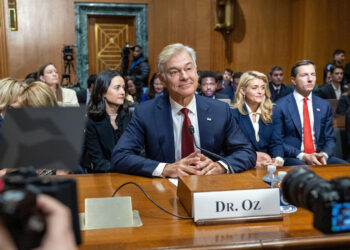When Gury Doshi, MD, learned that a patient’s insurance didn’t cover her breast cancer medication, Doshi had a potential workaround. The patient could try to bypass the insurer and access the drug at little or no cost through a patient assistance program hosted by the drug manufacturer.
Almost all major pharmaceutical companies offer this type of financial assistance to patients who meet certain eligibility criteria, which has generally included those who are uninsured or underinsured and likely wouldn’t be able to afford such expensive prescriptions.
Estimates suggested that companies spend about $4 billion a year to keep these financial assistance programs running, and the programs include steep discounts for more than 300 drugs overall.
As Doshi soon discovered, the list included the breast cancer drug her patient needed.
The 59-year-old patient was approved for the drugmaker’s patient assistance program and soon began receiving the oral breast cancer agent at no cost, said Doshi, a medical oncologist and hematologist at Texas Oncology in Houston.
However, the drugmaker recently announced that patients with commercial health insurance would no longer be eligible for its patient assistance program starting in 2025.
“Now, we don’t know what’s going to happen for her,” Doshi explained. “It’s very disconcerting to say, ‘We were able to work things out to get you started on medication, but we don’t know what’s going to happen next year.’”
“It’s very traumatizing for patients,” Doshi said.
Oncologists and patients across the country are increasingly encountering this problem, as more drug manufacturers are banning or restricting commercially insured patients from their patient assistance programs. Since 2023, several major drug manufacturers — AstraZeneca, Bristol-Myers Squibb, Johnson & Johnson, Pfizer, and most recently Novartis — made this move, leaving thousands of previously eligible patients without this financial support. After facing pushback, however, AstraZeneca changed course in late 2024 and began allowing certain eligible commercially-insured patients to enter its AZ&Me program again. According to the company, these may include patients who have been denied coverage by their plan, who have exhausted their copay benefit, or who don’t have a prescription plan as part of their benefit.
Outside of patient assistance programs, which often provide the most comprehensive help, patients have several other pharmacy assistance options, such as copay assistance or foundation-based grants. And about one third of patients prescribed oral anticancer drugs rely on either pharmaceutical company– or foundation-sponsored financial assistance programs.
“Many of our patients are only able to access these life-saving or life-prolonging therapies through assistance programs as their copays would otherwise be prohibitive,” Meera Ragavan, MD, MPH, a medical oncologist at Kaiser Permanente San Francisco Medical Center, San Francisco, told Medscape Medical News.
But with drug companies tightening access to this essential financial lifeline, patients and oncologists are left scrambling to find other ways to get these treatments.
Inside Insurer Cost-Shifting
What’s fueling patients’ growing reliance on pharmacy assistance programs?
There are several key factors at play here.
First, cancer drugs are getting more expensive. The average annual cost of new cancer drugs in the United States rose by 53% between 2017 and 2021, from $185,000 to more than $283,000 a year, according to The Lancet Oncology.
Second, insurance companies are increasingly restricting the cancer drugs they will cover and finding ways to defer the costs of these expensive agents to others. About 1 in 4 patients say their commercial health plan deems their specialty medication to be a “nonessential health benefit,” according to a 2023 poll from the PAN Foundation, a healthcare advocacy organization. The poll found that about 1 in 3 respondents said their plan directed them to find financial assistance for their specialty medication. The same percentage were told that any financial aid they received for their specialty medication would not count toward their deductible or out-of-pocket maximum.
In fact, the existence of patient assistance programs may provide “little incentive for payors to provide robust coverage of specialty drugs or for manufacturers to lower drug prices,” Ragavan and colleagues wrote in their review.
In recent years, insurers have been ramping up cost-shifting strategies to reduce their own spending on expensive drugs. These strategies include copay accumulator and maximizer programs as well as alternative funding programs, all run by third parties.
With copay accumulator programs, patients receive a copay card from the manufacturer with a fixed amount to help them pay for the drug. The caveat to a copay card is the funds do not count towards a patient’s out-of-pocket maximums and, depending on the amount and the cost of the drug, the funds can be depleted quickly.
Copay maximizer programs are features of an insurance plan that maximize the amount of manufacturer copay assistance a patient receives. When patients enroll in these programs, a third party determines the maximum amount of copay assistance available from the manufacturer and the insurance plan sets the patient’s copay to that amount. However, these programs also bar the manufacturer’s payments from counting toward a patient’s deductible and out-of-pocket maximum.
“When you buy insurance, you figure you’ve got a deductible and you’ve got some copays, but eventually you’ll get to the place where the insurance company picks up the whole burden,” said Barbara L. McAneny, MD, a medical oncologist/hematologist who practices in the Albuquerque, New Mexico area. “That’s how insurance works. But with copay accumulators and maximizers, [insurers] play games in such a way that the patients can never get to their complete out-of-pocket max.”
The third-party vendors that run alternative funding programs claim to help employers reduce their healthcare costs by assuming a health plan’s responsibility for covering specialty drugs. Under these programs, insurance plans define specialty medications as nonessential and notify patients they must enroll in an alternative funding program to get the medication they need. Alternative funding programs, however, generally exclude or deny specialty drugs and then help patients access the medications through drugmaker patient assistance programs. In most cases, patients are required to work with alternative funding programs or are left paying the full cost of their medications.
Copay accumulator and maximizer programs as well as alternative funding programs are now common among commercial insurance plans, according to a 2024 analysis. In 2022, an estimated 39% of commercially insured patients were enrolled in plans with copay accumulators, 41% had plans with copay maximizers, and 12% were enrolled in plans with alternative funding programs, according to the study.
With oral anticancer agents getting more expensive, patients may be relying more heavily on financial assistance programs, and this growing reliance may be driving drug companies to limit patients’ eligibility.
According to a spokesperson for Pharmaceutical Research and Manufacturers of America, a trade association for pharmaceutical manufacturers, the wave of pharmacy assistance program restrictions is a reaction to the increasing coverage restrictions from insurers.
When asked directly by Medscape Medical News, however, drug companies did not address this specific claim.
In 2024, Pfizer announced that it would no longer accept new commercially insured oncology patients into its patient assistance program. A spokesperson for Pfizer said its patient assistance program is “designed to serve patients with the greatest financial need,” and as more options become available to help patients afford their medicines, Pfizer reviews and updates the eligibility criteria of its patient assistance program to ensure the company can continue to provide a wide range of medicine free of cost to eligible patients, the spokeswoman said.
“We understand that these changes may affect some of our patients and are working to ensure a smooth transition,” the spokeswoman said.
A spokesperson for AstraZeneca noted that its AZ&Me patient assistance program was never designed for patients with commercial insurance. Although that option was removed after July 2023 “to protect the integrity of the program,” the company backtracked late last year and began allowing commercially insured patients once again.
“In reality, the drug companies are figuring out real quick, ‘I’m not playing this game anymore. You’re making these patients pay all these premiums, but you’re not actually wanting to help the patient and pay for their drugs.’” said Lindsey Scott, manager of pharmacy services for Texas Oncology. “The drugmakers are sick of it, so they’re refusing to accept commercially-insured patients into their patient assistance programs.”
But, Scott said, this tug of war between health insurers and drug companies ultimately “leaves the patient right smack in the middle.”
Restrictions Put Patients in Jeopardy
For patients who have been taking cancer medications for years, the new restrictions to patient assistance programs are disrupting regimens and putting progress at risk, said Brooke Looney, PharmD, a clinical pharmacist with the outpatient oncology specialty pharmacy at Vanderbilt University Medical Center in Nashville, Tennessee.
Looney recalled a grocery store employee in his 40s whose oral cancer treatments had kept his metastatic melanoma under control for 4 years. The total price for his two medications is $45,000 a month. The patient’s commercial insurance includes a pharmacy benefit plan that covers up to 45% of specialty medications.
In past years, the patient used a copay card, which allotted $25,000 a year toward his out-of-pocket costs, said Looney, who provides access support to patients on oral anticancer medications at Vanderbilt. After the card was maxed out, the patient qualified for the drugmaker’s patient assistance program, which paid the remaining cost.
But in 2024, the patient was excluded from the financial assistance program because commercial insurance was no longer allowed, Looney said. That means, after about 1 month of copay help, the patient would be left paying about $25,000 a month.
For months, Looney and her team exhausted all efforts trying to help the patient pay for his medication, appealing to his human resources department, the pharmacy plan, and the drugmaker.
But nothing worked.
“The patient worried how he would continue the medication that had worked for 4 years to keep him stable and stop his disease from progressing,” Looney said. “I was thinking, ‘We’ve got to keep fighting because there’s no way we can let this patient go off therapy.’”
Looney’s team supplemented the patient with samples of the medications while they continued to write letters, make calls, and search for financial assistance, she said.
Finally, the team secured more funding for him through an internal assistance program run by the pharmacy that contracts with his insurer. The program agreed to cover the remaining medication costs.
“That’s our Band-Aid” for now, Looney said. But “it makes me nervous.”
“If that pharmacy ever deems him ineligible, or they change their parameters, it’s going to come back to us again to try to figure out how to get him the medication,” Looney said.
Cancer care center staff often work tirelessly to help patients access their medication, but much of the burden can fall on patients, Doshi added. Some plans or human resources departments will only discuss financial matters with patients, and patients are frequently forced to endure endless back-and-forth, she said.
Patients left with paying high out-of-pocket costs for cancer medications are at greater risk for forging their treatment.
A study in the Journal for Clinical Oncology found that higher out-of-pocket costs were associated with increased rates of delayed initiation and abandonment of insurer-approved prescriptions for a new course of therapy with a novel oral anticancer agent.
Almost half the patients who faced out-of-pocket costs of more than $2000 for their first prescription, abandoned their approved oral anticancer prescription at the pharmacy.
“Certainly, any delay in initiating cancer treatment delays [successful] outcomes,” Doshi said. “Because of the patient assistance program exclusions, we are seeing delays in patients starting on medication, and that delay in starting treatment or having access to treatment has a negative impact on their disease and on their life.”
Is There an Answer?
Although the oncology community has issued sharp criticism against insurers and the third-party companies behind the copay and alternative funding programs, there has been no overarching solution so far.
In some cases, drug companies have taken legal action against third-party vendors for allegedly taking advantage of their assistance programs.
In 2023, Johnson & Johnson filed a lawsuit against SaveOnSP, a copay assistance program. SaveOnSP is run by Express Scripts, a pharmacy benefit manager owned by health insurance giant Cigna, and works with specialty pharmacy Accredo Health Group, Inc.
In the suit, Johnson & Johnson claimed the copay assistance program had been inflating copays for certain medications and then billing Johnson & Johnson’s copay assistance program, Janssen CarePath.
Inflating patient copays ultimately reduces what health insurers pay for these drugs and “extracts patient assistance support away from Janssen CarePath for the financial benefit of SaveOnSP and its partners,” according to the suit.
AbbVie filed a similar lawsuit against the alternative funding plan, Payer Matrix, in 2023 in the US District Court for the Northern District of Illinois. In that case, AbbVie alleged Payer Matrix employs a fraudulent scheme that exploits AbbVie’s charitable assistance program.
Payer Matrix has denied the allegations and contends it’s a “pioneering advocacy organization” that partners with employer groups nationwide to “mitigate the financial risk associated with the ever-rising costs of these types of drugs,” according to court documents.
Oncologists and patient advocates say alternative funding programs are more challenging to regulate but some states have passed copay accumulator legislation. At least 19 states, the District of Columbia, and Puerto Rico have laws requiring insurers to count copay assistance toward patients’ deductibles. And in 2024, Tennessee proposed legislation that would prohibit insurer, pharmacy benefits manager, or a third party from altering health insurance coverage benefits based on the availability of financial assistance for a prescription drug.
“We have tried to bring awareness at the state legislature levels, and we actively continue to work through societies like Community Oncology Alliance and with our health policy leadership through US Oncology,” Doshi said. “But we’re the ones speaking out on behalf of patients. The burden is too much to put on the backs of cancer patients.”
Alicia Gallegos is a freelance healthcare reporter based in the Midwest.
Source link : https://www.medscape.com/viewarticle/drugmakers-are-limiting-cancer-patients-access-financial-2025a1000120?src=rss
Author :
Publish date : 2025-01-16 10:40:48
Copyright for syndicated content belongs to the linked Source.














